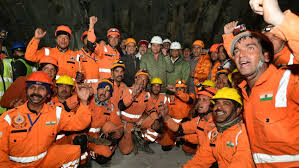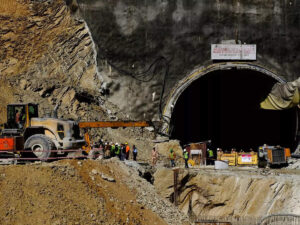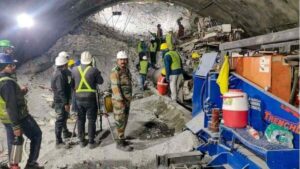Silkyara – Barkot tunnel collapse and rescue operation
What happened: A portion of the Silkyara Bend-Barkot Tunnel had collapsed, resulting in 41 workers being trapped inside.
When: The incident took place on November 12 at 5.30 am in the morning.
Where: The incident took place in Uttarkashi district of Uttarakhand state of India.
How: The government has announced an investigation into the cause of the collapse.
Result: All 41 workers who were trapped in the tunnel were successfully rescued on November 28, 17 days after the incident occurred.

Uttarkashi Tunnel Collapse:
About Silkyara Tunnel

The Silkyara Tunnel, spanning 4.5 km, is a crucial part of the Centre’s Char Dham project, which aims to ensure all-weather connectivity among the Hindu shrines of Badrinath, Kedarnath, Gangotri, and Yamunotri.
The tunnel links Silkyara and Dandalgaon
- Connecting Silkyara and Dandalgaon in Uttarkashi district, the tunnel is expected to significantly reduce travel time between the two locations by an hour once completed.
Construction company involved:
- The construction of the tunnel is being carried out by the Hyderabad-based Navayuga Engineering Company Limited.
Char Dham all weather road project
- The Char Dham all-weather road project is an initiative aimed at expanding highways, covering a distance of 889 km, to ensure all-weather connectivity in the Char Dham circuit.
- Envisioned in 2016, this project focuses on improving road infrastructure leading to Uttarakhand’s four major shrines situated in the upper Himalayas—Badrinath, Kedarnath, Gangotri, and Yamunotri.
Critical Aspects of Tunnel Construction
Tunnel Excavation Techniques:
1. Drill and Blast Method (DBM): Involves drilling holes into rock and detonating explosives to break it apart.
- DBM is often used in regions like the Himalayas (Jammu & Kashmir and Uttarakhand) due to the challenging terrain.
2. Tunnel-Boring Machines (TBMs): It bore through rock while supporting the tunnel behind with precast concrete segments.
- It is a more expensive but safer method. TBMs are ideal when the rock cover is up to 400 metres tall. Underground tunnels for the Delhi Metro were dug using a TBM at shallow depth.
Aspects in Tunnel Construction:
1. Rock Exploration: Comprehensive Evaluation of Rock Strength and Composition through Seismic Waves and Petrographic Analysis for Load-Bearing Capacity and Stability Assessment.
2. Surveillance and Structural Reinforcement: Ongoing Monitoring Utilizing Stress and Deformation Meters, Supported by Various Mechanisms Including Shotcrete, Rock Bolts, Steel Ribs, and Specialized Tunnel Pipe Umbrellas.
3. Geological Expertise: Critical Role of Independent Geologists in Tunnel Examination, Failure Prediction, and Assessment of Rock Stability Duration.
What is Rat-hole Mining Technique?
Rat-hole mining is a manual mining technique using hand-held tools to extract coal from small mines, resembling tunnels dug by rats.
- Miners create small pits, not exceeding 4 feet wide, to access the coal seam, then dig sideways tunnels.
- The practice was banned by the National Green Tribunal in 2014 due to its unscientific nature.
- Despite the ban, rat-hole mining continues in several Indian states, mainly in the Northeast, as they argue there are no viable mining alternatives in the region.
Rescue Operation initiated: “Operation Zindagi”

“Operation Zindagi” is a rescue operation launched by the state government to save 41 workers who were trapped inside the tunnel.
- The operation involves the use of two tunnel-boring machines. Throughout the rescue mission in the Uttarakhand tunnel collapse, three vital connections were established to support the stranded workers.
These include
- an oxygen pipeline, a dry food conduit, and a broader pipe designed for delivering hot meals and facilitating camera insertion.
The rescue operation in the Uttarakhand tunnel is a collaborative effort involving the NDRF, SDRF, Indian Army, and various state and central agencies.
- IAS officer Neeraj Khairwal has been appointed as the Nodal officer for the Silkyara tunnel collapse.
Additionally, the team has been strengthened by the presence of Chris Cooper, a micro-tunneling expert. Overseeing the rescue operations on behalf of the National Disaster Management Authority (NDMA) is Syed Ata Hasnain, a retired Lieutenant General of the Indian Army.
Role of Australian tunnelling expert Professor Arnold Dix:

- Under the supervision of Australian underground tunnelling expert Professor Arnold Dix, the workers excavated a tunnel and utilized rat-hole mining techniques to rescue the 41 trapped workers.
Note:
- Arnold Dix is the head of the Geneva-based International Tunnelling and Underground Space Association.
Other major Tunnels in India
1. Dr Syama Prasad Mookerjee Road Tunnel: Previously known as Chenani-Nashri Tunnel is a road tunnel in Jammu and Kashmir, India.
- It is located in the Lower Himalayas, on National Highway 44.
2. Jogindernagar Tunnel: Located in Himachal Pradesh, this tunnel is a part of the Kangra Valley Railway.
- It is the longest narrow-gauge railway tunnel in India, measuring approximately 2.8 km.
3. Karora Tunnel: Situated in Jammu and Kashmir, the Karora Tunnel is a railway tunnel that is a crucial part of the Udhampur-Srinagar-Baramulla Rail Link project.
4. Nathula Pass Tunnel: Connecting India and China, this tunnel is strategically significant and is located at an altitude of around 14,140 feet in Sikkim.
- It facilitates all-weather movement for the armed forces.
5. Zoji La Tunnel: Planned to be one of the longest tunnels in Asia, the Zoji La Tunnel is proposed to connect Srinagar and Leh. It is designed to make the Zoji La Pass accessible throughout the year.
Note:
These tunnels play a crucial role in improving connectivity, especially in regions with challenging geographical terrain such as mountain ranges and passes. They contribute to the development of infrastructure, transportation, and overall accessibility in various parts of the country.
Thanks
Happy reading!











